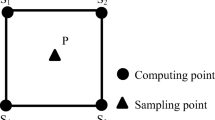Abstract
The DEM generalization is the foundation of expressing and analyzing the terrain and the basis of multi-scale observation. Meanwhile, it is also the core of building the multi-scale geographic database. This paper would like to propose a new algorithm using profile simplification in four directions(4-DP). This algorithm is composed of two parts, namely extraction of terrain feature points in local window as well as in global profile line and reconstruction of DEMs. The paper used the 5 m resolution DEM of the Suide in Loess Plateau of China as the original data. In the experiment, this paper has achieved the generalized DEM with 5 m and 25 m resolution by removed small details and computed out the optimal threshold. In contrast to the classic algorithms, VIP and Aggregate, based on three evaluation methods. The results show that this method is able to retain the main geographical information effectively in terrain surface.












Similar content being viewed by others
References
Baella B, Pla M (1999) Map generalization to obtain the topographic map of Catalonia 1:10000, Proceedings of Third Workshop on Progress in Automated Map Generalisation, pp. 54–62
Chen Z-T, Guevara JA (1987) Systematic selection of very important points (VIP) from digital terrain model for constructing triangular irregular networks, Auto-carto, pp. 50–56
Chen Y, Wilson JP, Zhu Q et al (2012) Comparison of drainage-constrained methods for DEM generalization[J]. Comput Geosci 48:41–49
De Floriani L, Falcidieno B, Pienovi C (1983) A Delaunay-based method for surface approximation. Eurographics’ 83:333–350
De Floriani L, Magillo P, Puppo E (2000) VARIANT: a system for terrain modeling at variable resolution[J]. GeoInformatica 4(3):287–315
Dong Y, Tang G (2013) Research on terrain simplification using terrain significance information index from digital elevation models. Geomatics and Information Science of Wuhan University 38:353–357
Douglas DH, Peucker TK (1973) Algorithms for the reduction of the number of points required to represent a digitized line or its caricature. Cartographica: The International Journal for Geographic Information and Geovisualization 10:112–122
Evans IS (2012) Geomorphometry and landform mapping: what is a landform? Geomorphology 137:94–106
Fei L, He J (2009) A three-dimensional Douglas–Peucker algorithm and its application to automated generalization of DEMs. Int J Geogr Inf Sci 23:703–718
Garland M, Heckbert PS (1995) Fast polygonal approximation of terrains and height fields. School of Computer Science, Carnegie Mellon University Pittsburgh, USA
Guilbert E, Gaffuri J, Jenny B (2014) Terrain generalisation[M]Abstracting Geographic Information in a Data Rich World. Springer International Publishing: 227–258
Heller M (1990) Triangulation algorithms for adaptive terrain modeling, Proc. 4th Intl. Symp. on Spatial Data Handling, pp. 163–174
Jordan G (2007) Adaptive smoothing of valleys in DEMs using TIN interpolation from ridgeline elevations: an application to morphotectonic aspect analysis. Comput Geosci 33:573–585
Lee J (1991) Comparison of existing methods for building triangular irregular network, models of terrain from grid digital elevation models. International Journal of Geographical Information System 5:267–285
Liu XJ, Hua-Xing LU, Ren Z et al (2007) Scale issues in digital terrain analysis and terrain modeling[J]. Geogr Res 26(3):433–442
Lou S, Jiang X, Scott PJ (2013) Application of the morphological alpha shape method to the extraction of topographical features from engineering surfaces. Measurement 46:1002–1008
Meynen E, Association IC (1973) Multilingual dictionary of technical terms in cartography. Steiner
State Bureau of Surveying and Mapping (2001) 1:10000 and 1:50000 digital elevation model. The Basic Digital Geographical Information Product, Standard CH/T 1008–2001. The State Bureau of Surveying and Mapping of China (in Chinese)
Tang Ga, Ge S, Li F, Zhou J (2005) Review of digital elevation model (DEM) based research on China Loess Plateau. J Mt Sci 2:265–270
Vieux BE (1993) DEM aggregation and smoothing effects on surface runoff modeling[J]. J Comput Civ Eng 7(3):310–338
Vivoni ER, Ivanov VY, Bras RL, Entekhabi D (2004) Generation of triangulated irregular networks based on hydrological similarity. J Hydrol Eng 9:288–302
Weibel R (1992) Models and experiments for adaptive computer-assisted terrain generalization[J]. Cartography and Geographic Information Science 19(3):133–153
Xiong L-Y, Tang G-A, Li F-Y, Yuan B-Y, Lu Z-C (2014) Modeling the evolution of loess-covered landforms in the Loess Plateau of China using a DEM of underground bedrock surface. Geomorphology 209:18–26
Zhou Q, Chen Y (2011) Generalization of DEM for terrain analysis using a compound method. ISPRS J Photogramm Remote Sens 66:38–45
Acknowledgements
Financial support for this research was provided by the National Natural Science Foundation of China (41201408), Zhejiang Province Ecological Public Welfare Program (2014C32119) and Zhejiang Provinace Natural Science Foundation of China (LY16D010009). The authors also gratefully acknowledge the journal editor and three anonymous reviewers for thoughtful and highly appreciated comments.
Author information
Authors and Affiliations
Corresponding author
Additional information
Communicated by: H. A. Babaie
Rights and permissions
About this article
Cite this article
Ma, T., Chen, Y., Hua, Y. et al. DEM generalization with profile simplification in four directions. Earth Sci Inform 10, 29–39 (2017). https://doi.org/10.1007/s12145-016-0275-1
Received:
Accepted:
Published:
Issue Date:
DOI: https://doi.org/10.1007/s12145-016-0275-1




